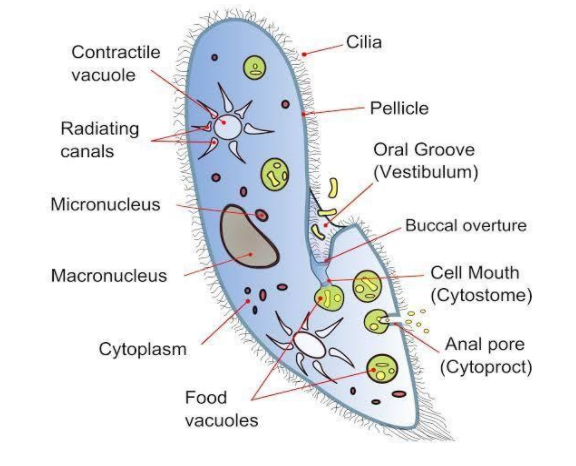
The cilia in Paramecium are
A. All equal
B. All unequal
C. Longer at the posterior end
D. Longer at the anterior end
Answer
477.3k+ views
Hint: The Paramecium is a eukaryotic single-celled organism that varies from thirty to three hundred micrometres in length. The entire body of the Paramecium is enclosed in small hair-like filaments known as the cilia.
Complete answer: The Paramecium is a member of the phylum Protozoa and class Ciliata. They are also termed as slipper animalcules. They are a single-celled eukaryotic organism that possesses two kinds of nuclei.

The four species of Paramecium are:
a) Paramecium caudatum
b) Paramecium aurelia
c) Paramecium multimicronucleatum
d) Paramecium bursaria or Green bursaria
The cilia that are present in the Paramecium helps in moving or locomotion. It also plays a vital role in the organism to move food to the oral cavity. The cilia are arranged uniformly over the body in longitudinal rows. These rows are equidistant over the entire body. The presence of cilia on an organism is also termed as holotrichous. Also, the cilia are composed of the plasma membrane that has longitudinal fibrils. They are moderate and are nearly uniform in length, but at the posterior end, cilia are quite larger and longer called caudal tufts. These longitudinal fibrils are of two types, namely the inner fibrils and the outer fibrils. The inner fibrils are much thinner than outer fibrils.
Hence, the correct answer is option C.
Note: The Paramecium possesses two types of nucleus. These two types are termed as the micronucleus and the macronucleus. The micronucleus is the reproductive nucleus, whereas the macronucleus is defined as the vegetative nucleus. Also, the micronucleus is categorised into two nuclei by the process of mitosis, and the macronucleus splits into two parts.
Complete answer: The Paramecium is a member of the phylum Protozoa and class Ciliata. They are also termed as slipper animalcules. They are a single-celled eukaryotic organism that possesses two kinds of nuclei.

The four species of Paramecium are:
a) Paramecium caudatum
b) Paramecium aurelia
c) Paramecium multimicronucleatum
d) Paramecium bursaria or Green bursaria
The cilia that are present in the Paramecium helps in moving or locomotion. It also plays a vital role in the organism to move food to the oral cavity. The cilia are arranged uniformly over the body in longitudinal rows. These rows are equidistant over the entire body. The presence of cilia on an organism is also termed as holotrichous. Also, the cilia are composed of the plasma membrane that has longitudinal fibrils. They are moderate and are nearly uniform in length, but at the posterior end, cilia are quite larger and longer called caudal tufts. These longitudinal fibrils are of two types, namely the inner fibrils and the outer fibrils. The inner fibrils are much thinner than outer fibrils.
Hence, the correct answer is option C.
Note: The Paramecium possesses two types of nucleus. These two types are termed as the micronucleus and the macronucleus. The micronucleus is the reproductive nucleus, whereas the macronucleus is defined as the vegetative nucleus. Also, the micronucleus is categorised into two nuclei by the process of mitosis, and the macronucleus splits into two parts.
Recently Updated Pages
Master Class 11 Economics: Engaging Questions & Answers for Success

Master Class 11 Business Studies: Engaging Questions & Answers for Success

Master Class 11 Accountancy: Engaging Questions & Answers for Success

Master Class 11 English: Engaging Questions & Answers for Success

Master Class 11 Computer Science: Engaging Questions & Answers for Success

Master Class 11 Maths: Engaging Questions & Answers for Success

Trending doubts
Which one is a true fish A Jellyfish B Starfish C Dogfish class 11 biology CBSE

State and prove Bernoullis theorem class 11 physics CBSE

1 ton equals to A 100 kg B 1000 kg C 10 kg D 10000 class 11 physics CBSE

In which part of the body the blood is purified oxygenation class 11 biology CBSE

One Metric ton is equal to kg A 10000 B 1000 C 100 class 11 physics CBSE

Difference Between Prokaryotic Cells and Eukaryotic Cells




